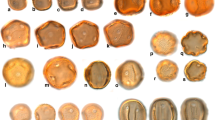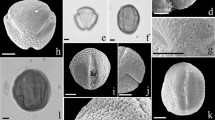Abstract
Pollen morphology from 143 collections representing 11 genera and 75 species of native South American Convolvulaceae was analyzed with LM and SEM. Exine structure and sculpture allow to distinguish three main types, in two of these types some subtypes were recognized. 1) Tectate, microechinate-perforate exine, with ramified columellae. On the basis of apertures three subtypes were distinguished: tricolpate in Aniseia, Bonamia, Convolvulus, Cressa, Dichondra, Merremia and Jacquemontia blanchetii; penta-hexacolpate in Merremia umbellata; and pantoporate with elliptic and circular pores, in Calystegia. 2) Tectate, microechinate-perforate exine with microspines and single columellae in concordant pattern, relates pantocolpate pollen of Jacquemontia and Evolvulus. From pollen data generic status of J. blanchetii should be considered. 3) Semitectate, echinate or gemmate, microechinate-microreticulate exine with single columellae is exclusive of pantoporate pollen of Ipomoea. Four subtypes were recognized in this genera, which are discussed in relation to Austin’s infrageneric classification.
Similar content being viewed by others
Author information
Authors and Affiliations
Corresponding author
Rights and permissions
About this article
Cite this article
Tellería, M., Daners, G. Pollen types in Southern New World Convolvulaceae and their taxonomic significance. Plant Syst. Evol. 243, 99–118 (2003). https://doi.org/10.1007/s00606-003-0069-z
Received:
Published:
Issue Date:
DOI: https://doi.org/10.1007/s00606-003-0069-z




